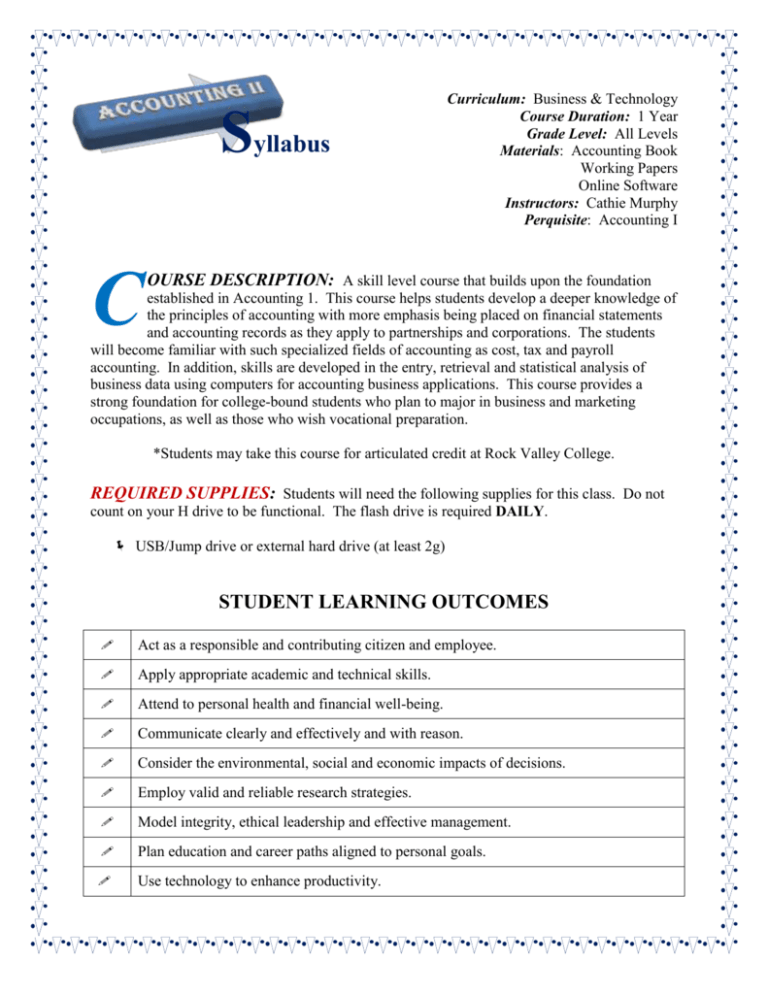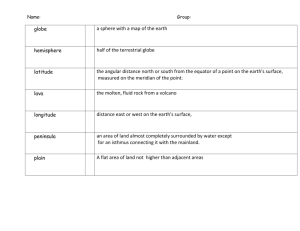SVHS Accounting II Syllabus
advertisement

Syllabus C Curriculum: Business & Technology Course Duration: 1 Year Grade Level: All Levels Materials: Accounting Book Working Papers Online Software Instructors: Cathie Murphy Perquisite: Accounting I OURSE DESCRIPTION: A skill level course that builds upon the foundation established in Accounting 1. This course helps students develop a deeper knowledge of the principles of accounting with more emphasis being placed on financial statements and accounting records as they apply to partnerships and corporations. The students will become familiar with such specialized fields of accounting as cost, tax and payroll accounting. In addition, skills are developed in the entry, retrieval and statistical analysis of business data using computers for accounting business applications. This course provides a strong foundation for college-bound students who plan to major in business and marketing occupations, as well as those who wish vocational preparation. *Students may take this course for articulated credit at Rock Valley College. REQUIRED SUPPLIES: Students will need the following supplies for this class. Do not count on your H drive to be functional. The flash drive is required DAILY. USB/Jump drive or external hard drive (at least 2g) STUDENT LEARNING OUTCOMES Act as a responsible and contributing citizen and employee. Apply appropriate academic and technical skills. Attend to personal health and financial well-being. Communicate clearly and effectively and with reason. Consider the environmental, social and economic impacts of decisions. Employ valid and reliable research strategies. Model integrity, ethical leadership and effective management. Plan education and career paths aligned to personal goals. Use technology to enhance productivity. Work productively in teams while using cultural global competence. Utilize critical thinking to make sense of problems and persevere in solving them. METHOD OF STUDENT INSTRUCTION Class Activities Hands on work Small Group work One-on-one contact METHOD OF STUDENT ASSESSMENT _x_ _x_ _x_ _x_ Hands on Test and/or Quizzes Problem Solving Exercises Unit Testing Accounting Mini Projects Student Essential Outcomes 16. Prepare the Sales Journal & Cash Receipts Journal by: a. Identifying special journals & how they are used. b. Recording sales of merchandise on account in the sales journal c. Recording receipt of all cash into Cash Receipts Journal d. Posting from the Sales Journal to the General Journal & A/R Subsidiary Ledger e. Posting from the Cash Receipts Journal to General Journal & A/R Subsidiary Ledger f. Footing, proving, totaling & ruling sales journal & cash receipts journal g. Connecting key terms in the chapter with application 17. Prepare the Purchases & Cash Payments journals by: a. Explaining the purpose of the purchases & cash payments journals b. Recording transactions in the purchases & cash pavements journals c. Posting from the special journals to the General Ledger & Subsidiary Ledgers d. Totaling, proving & ruling the purchases & cash payments journals e. Preparing a schedule of accounts payable f. Proving cash. g. Connecting key terms in the chapter with application 18. Prepare a Ten-Column Worksheet by: a. Describing the parts of a ten-column work sheet. b. Determining which general ledger accounts are adjusted. c. Calculating the adjustments. d. Preparing a ten-column worksheet. e. Journalizing the adjustments. f. Connecting key terms in the chapter with application 19. Prepare financial statements for corporations by: a. Identifying how to record ownership of a corporation. b. Explaining relationship between the worksheet & financial statements for merchandising business c. Explaining how financial statements for a corporation differ from those for a sole proprietorship. d. Preparing an income statement, balance sheet, & statement of retained earnings for merchandising corporations. e. Analyzing the financial data contained on the statements. f. Connecting key terms in the chapter with application 20. Close the books for a merchandising corporation by: a. Journalizing closing entries for merchandising corporation b. Posting closing entries to the general ledger accounts c. Preparing a post-closing trial balance d. Identifying the steps in the accounting cycle. e. Connecting key terms in the chapter with application 21. Determine distribution of earnings for corporations by: a. Comparing & contrasting the characteristics of the corporate form of business organizations. b. Preparing journal entries to record the issue of stock to investors. c. Preparing journal entries to record the distribution of earnings to owners. d. Preparing financial statements for publicly held corporations. e. Connecting key terms in the chapter with application 22. Establish, maintain, and replenish the petty cash and change fund by: a. Recording the entry to establish a change fund & petty cash fund. b. Proving the cash in cash register drawers at end of each business day. c. Preparing a petty cash requisition to replenish the petty cash fund. d. Journalizing the journal entry to replenish the petty cash fund. e. Determining whether cash is short or over & record amount of shortage or overage f. Connecting key terms in the chapter with application 23. Figuring Depreciation by: a. Categorizing currents assets vs plant assets b. Explaining the need to depreciate plant assets c. Calculating the annual depreciation expense of a plant asset d. Calculating depreciation for a partial year e. Determining book value of a plant asset f. Journalizing & posting adjusting entries in the general journal for depreciation g. Connecting key terms in the chapter with application 24. Determining uncollectible accounts receivable and the adjust the account records to reflect unpaid balances by: a. Explaining direct write-off method & allowance method of accounting for uncollectible b. Journalizing the entry to record the direct write off method c. Journalizing adjusting entry for estimated uncollectible accounts d. Journalizing entry to write off an uncollectible account using allowance method e. Journalizing entry to record collection of an account previously written off f. Connecting key terms in the chapter with application 25. Calculate cost of merchandise by: a. Explaining the importance of maintaining accurate inventory records b. Identifying the difference between a periodic & perpetual inventory system c. Determining the cost of merchandise inventory using: i. FIFO ii. LIFO iii. Specific Identification iv. Weighted Average d. Assigning value to merchandise using lower-of-cost or market rule e. Connecting key terms in the chapter with application 26. Prepare Notes Payable & Notes Receivable by: a. Identifying how promissory notes are used by business b. Determining the due date, interest expense, & maturity value of a promissory note c. Explaining the difference between interest-bearing & noninterest-bearing notes d. Calculating & recording journal entries for notes payable & receivable e. Connecting key terms in the chapter with application 27. Allocate profits & losses for partnerships by: a. Identifying the characteristics of partnerships b. Accounting for investments in a partnership c. Accounting for partners’ withdrawals d. Allocating profits & losses to partners by different methods e. Connecting key terms in the chapter with application 28. Record transactions related to the capital accounts of a partnership by: a. Preparing an income statement, statement of partners’ equity & the Partner’s equity section of a balance sheet b. Accounting for partnership liquidation gains & losses c. Preparing the final entry to liquidate a partnership d. Connecting key terms in the chapter with application





